Restoration work at the Palace of Pena reveals original decorative paintings
01 Sept 2025
The latest discovery reveals that the National Palace of Pena still has many secrets to uncover. During conservation and restoration work, the original decorative painting of The Gallery’s second room was unveiled and restored. This is the painting chosen by King Ferdinand II – the monarch who commissioned the construction of the Palace – for this room, which had been hidden by the last intervention dating from the 20th century. Visitors can now admire a room decorated in shades of blue, with frames in ochre tones, where the painting presents an oriental suggestion, potentially inspired by Chinese motifs, with floral patterns on the walls and, on the ceiling, a trellis executed in the semi-trompe-l’oeil technique. The exotic atmosphere idealised by King Ferdinand II is completed with the furniture and other objects selected by the monarch for this space, which have now returned to the original location following the review of the museography.
Photographs from the early 20th century were the starting point, but there was more to discover
The conservation and restoration project for The Gallery’s first and second room of the National Palace of Pena — so named because they are located at the transition between the 16th-century monastery, adapted into the private section of the palace, and the New Palace, built to host guests — was preceded by in-depth research. In the case of The Gallery’s second room, although a smooth grey-blue wall covering was observed, the historical information obtained through photographic documentation indicated the possible existence of an earlier decorative painting on the walls.
In the first phase, the conservator-restorer teams conducted wall surveys that confirmed the existence of this previous campaign and led to a surprising discovery, which deserves special mention: the original decorative covering of the ceiling, of which no photographic record is known. The research carried out on-site, alongside the recording and documentation techniques inherent to the conservation methodology used by Parks of Sintra, made this finding possible.
To ensure the safeguarding of the existing remains, which served as the basis for the recovery of all the wall covering, a meticulous and time-consuming process was followed. The delicate intervention was carried out manually, using small-sized tools and removal techniques that were tested and specifically developed for the materials and the location in question.
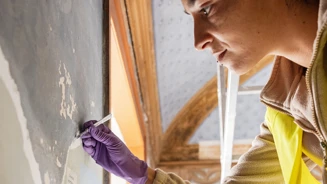
The implementation of this conservation and restoration project, which took about a year, involved a multidisciplinary team, composed of conservator-restorers, architects, and engineers, who contributed to defining the strategy and selecting the most suitable materials for the recovery of the space.
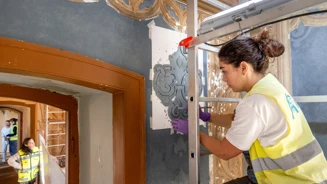
Probably executed in the 1860s by painters hired by the firm Barbosa and Costa (which, in addition to supplying furniture, textiles, and accessories, also served as contractor for decorative works), the original painting of The Gallery’s second room is of high artistic quality, revealing exceptional attention to the decoration of the walls of this room, which is now once again possible to observe. The repetition of vegetal medallions with slight gradations of tones evokes the textiles used in wall covering, typical of this historical-artistic phase.
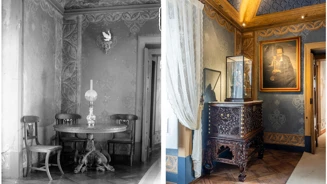
From light to shadow, between revivalism and exoticism
Conservation and restoration work has returned the Gallery Rooms to a state similar to that of the time of Ferdinand II: the first, in ochre tones, bright and luminous, marked by the revivalism of Neo-Gothic decorative painting; the second, dimly lit, features shades of blue and references to exoticism. This kind of abrupt contrast between light and shadow stimulates the senses and is a key feature of Romantic-period interior architecture.
In parallel, the Parks of Sintra conducted a detailed study of inventories, period correspondence, and the collections from the National Palace of Pena and other national palaces (Mafra and Ajuda), with the goal of musealising these rooms. In palaces and elite residences, these circulation spaces between private chambers often functioned as small galleries for artworks. The Palace of Pena followed this tradition.
The research, conducted with the aim of reconstructing (or approximating) these rooms according to the period when they were inhabited by the Portuguese Royal Family, led to the identification of furniture, ceramics, glassware, and sculptures used in these rooms during the monarchy. These pieces have now been returned to their original locations. The study also provided valuable information that helped in the selection and acquisition of paintings that once belonged to King Ferdinand II, thereby creating the effect of a small painting gallery.
This chapter highlights the acquisition of the works A Poor Blind Man (from life) by painter Francisco Pinto da Costa (1826–1869); Washerwoman, painted by Francisco de Resende (1825–1893); and a pair of still lifes on the theme Flowers by the Flemish artist Gaspar Peeter II Verbruggen (1664–1730).
Also displayed in these rooms are several paintings depicting the Sintra landscape and the Palace of Pena by the naturalist painter João Cristino da Silva (1829–1877), from whom King Ferdinand II purchased numerous works.
Returning to the Gallery’s First Room—referred to by the plasterer Domingos Meira in his invoices as the “Painting Room at the Entrance to the Atelier”—are pieces of antique Portuguese furniture carefully selected by the Artist-King for this space: a writing cabinet, a chest, and a neo-Gothic cabinet showcasing part of his glass collection. Other objects identified and returned to the room, which were also present during the monarch’s time, include a pair of German faience jars decorated with grapevines and grapes, and a French-made terrine shaped like a hare.
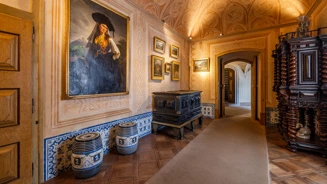
In the Gallery’s Second Room, the exotic atmosphere envisioned by King Ferdinand II is restored through the display of oriental or oriental-inspired pieces he selected for this space. Highlights include two chests made in India, a pair of ceramic sculptures representing a Chinese man and woman, and a black stoneware perfume burner of Chinese origin.
In the same vein of historically informed reconstruction of these rooms, research was also carried out on the curtains used during the monarchy. Nottingham lace curtains from Scotland, produced by Cooper Lace on a historic loom, were chosen, as they match the references found in period inventories and iconography.
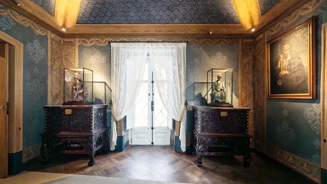
The intervention in the Gallery Rooms, particularly the restoration of their wall coverings, forms part of Parques de Sintra’s broader heritage safeguarding strategy. This strategy aims to preserve and recover the authenticity of the National Palace of Pena, a site of exceptional historical value, while enhancing both the interpretation and the overall visitor experience. According to the previously defined plan, the conservation and restoration of interior finishes will continue in the remaining spaces on the Palace’s Piano Nobile.
Simultaneously, the musealisation of these rooms forms part of the broader project currently being implemented throughout the interiors of the National Palace of Pena. This initiative aims to achieve a historically informed reconstruction of the domestic settings that characterised the daily life of the Royal Family in this monument. To this end, extensive historical research has been conducted, drawing on documentary sources and period iconography.
